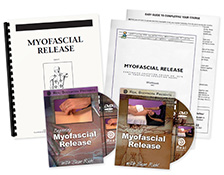 Want to earn continuing education credit for this article? Learn more.
Want to earn continuing education credit for this article? Learn more.
A growing awareness is emerging among massage therapists and other healthcare workers that traumatic experiences are widespread. It is very common for people who have been traumatized to develop medical and psychological symptoms associated with their experience. People that experience or witness life-threatening events such as military combat, natural disasters, terrorist incidents, serious accidents or violent personal assaults often re-live these experiences over and over again. This can occur through:
- Nightmares
- Flashbacks
- Difficulty sleeping
- Feelings of detachment or estrangement
- Development of physical pain from the mental/emotional impact of the event
One’s life is usually significantly affected and impaired when post-traumatic symptoms are chronic and severe.
Known as Post Traumatic Stress Disorder, or PTSD, the stress caused by trauma has a neurobiological basis that can disrupt and alter brain chemistry, influencing one’s behavior, feelings and thought processes significantly. An estimated 70 percent of adults in the U.S. have experienced a traumatic event. Of these individuals, about 8 percent of men and 20 percent of women go on to develop PTSD following a traumatic event. Roughly 30 percent of these individuals develop a chronic manifestation that persists throughout their lifetimes. Without any treatment for this disorder, many people may continue to have PTSD symptoms even decades after the traumatic event.
The PTSD Alliance, a multidisciplinary group of professionals and advocacy organizations, state that three categories or “clusters” of symptoms are associated with PTSD. They are:
- Re-living the event through recurring nightmares or other intrusive images that occur at any time. Extreme emotional or physical reactions such as chills, heart palpitations or panic when faced with the memory of the event. One or more of these symptoms must be present for diagnosis.
- Avoiding reminders of the event including places, people, thoughts or other activities associated with the trauma. Feelings of emotional detachment, withdrawal from friends and family, and loss of interest in everyday activities. Three or more of these symptoms must be present for diagnosis.
- Being on guard or hyper-aroused at all times, including feeling irritable or sudden anger, having difficulty sleeping or lack of concentration, being overly alert or easily startled. Two or more of these symptoms must be present for diagnosis.
A diagnosis of PTSD, according to the Alliance, may be considered if:
- A specific number of symptoms from each of three clusters have lasted for one month or longer
AND
- The symptoms cause severe problems or distress in personal life, at work or, in general, affect daily life.
Massage therapists and other bodyworkers are in the position to recognize physical symptoms and emotional issues affecting one’s basic needs in those with PTSD. Frequent physical complaints include chronic pain, fatigue, stomach pains, respiratory problems, headaches, muscle cramps, muscle aches or low back pain. Further indicators of PTSD include emotional absence and/or unresponsiveness, depression, exaggerated startle responses or extreme ticklishness, numbness or hypersensitivity to touch over parts or all of the body, migrating symptoms of physical pain, disassociation from self, actions or parts of the body, irritability and/or outbursts of anger or crying. In “Transforming the Pain: A Workbook on Vicarious Traumatization”, Saakvitne and Pearlman state that five basic human needs are undermined by the traumatic experience:
- The need to be safe.
- The need to trust.
- The need to feel some control over one’s life.
- The need to feel of value.
- The need to feel close to others.
Massage therapy and other forms of bodywork can offer a profound sense of peace to those who are present in their bodies enough to let go, relax and receive. However, for those who have been traumatized, the intimacy inherent in a massage treatment may increase their sense of fear and/or trigger painful memories. Certain kinds of touch, even gentle and caring touch, can have unpleasant associations for the client, particularly if they are survivors of sexual or physical abuse. In these cases, clients may not even be able to feel certain parts of their body or be able to give feedback as to how they are feeling physically or emotionally. Those who have suffered traumatic accidents may have feelings associated with the event locked into the musculature along with the messages of physical pain.
Treatment considerations for those with PTSD involve obtaining and evaluating the information about the traumatic event specifically and how the symptoms may be manifesting in the client. The massage therapist must take into account and work with any scope of practice regulations that could influence this evaluation. In all instances, but especially with those with PTSD, establishing a sense of trust as the basis of the therapeutic relationship is paramount. A commitment between therapist and client to work together toward the client’s wellness by creating a caring and safe environment for healing as well as developing a treatment plan that is mutually agreed upon are essential components for any therapeutic relationship. For people with PTSD, communication about these components, along with a well-defined and predictable massage routine, increase the effectiveness of treatment and reduce the potential for conflict and inadvertent re-traumatization by the therapist.
In concert with the safe, trusting and therapeutic healing environment, there are several treatment protocols that may be effective when working with those with PTSD.
- Polarity Therapy is unique in its comprehensive exploration of multiple dimensions of the human condition, and in its effective bridging of the full spectrum of life experiences, including body, mind and spirit. Using an energy-based approach, Polarity Therapy offers very effective methods for supporting a safe and sound therapeutic relationship and helping the client build the inner resources necessary to manage their own stress and trauma.
Polarity sessions do not require disrobing and involve both touch and verbal interaction. According to Mary Sullivan, author of The Institute for Integrative Healthcare Studies’ Polarity Therapy Manual, Satvic touch, or touch that is very still and non-intrusive, is useful for PTSD. This type of touch is used in Polarity to bring about awareness of one’s resistance to letting go of the tension, pain and fear stored in the tissues as a result of trauma. Ms. Sullivan states, “When you touch a place that has held trauma for a long time, the psyche responds by remembering scenarios that have brought on the pain.” With the re-emergence of memories associated with the trauma, the client may feel uncomfortable with touch in that area. It is imperative to respect the client’s process and wishes and move on to related reflex areas. Maintain a conscious, loving intention in which unconditional acceptance of the client and where they are in this process are held constant. The fact that the therapist consistently remains present and accepting of the client will have an enormous impact on the ability of the client to release, balance and heal.
- Therapeutic Touch (TT) is a contemporary interpretation of several ancient energy healing practices, which consciously directs or sensitively modulates the client’s human energy field to restore health and well-being. Research has shown that TT not only alleviates pain, but also induces a relaxation response. This is known to ameliorate levels of anxiety or the situational occurrences of anxiety associated with prolonged states of fear or trauma. A series of TT treatments may help to diminish defense mechanisms that have been constructed to block awareness of physical and emotional trauma, and allow for a deeper sense of self-awareness and body consciousness.
- Myofascial Release and/or Myofascial Unwinding are techniques that initiate release in two ways:
- Release of the fascial tissue restrictions held in the body from the trauma.
- Release of the emotional origin of the physical holding patterns.
As a skilled therapist holds and unwinds these tissue tensions, memories begin to surface and release, causing the body to spontaneously “replay” body movements that are associated with the memory of the trauma. As the body relaxes and fascial restrictions release, the nervous system takes over and releases stored tensions like the uncoiling of a spring, allowing trapped nerves to elongate and restore normal function. Repressed memories are brought to conscious awareness allowing the client to look at them in a new way and experience the choice to transform them.
A holistic approach to therapy for recovery from PTSD is advantageous because instead of facilitating just a structural change in the body, it helps to create a whole-body centered awareness. This allows for positive personal growth and the possibility for a more total resolution of physical and psychological restrictions, emotions and belief systems that are impediments to one’s health and well-being. Massage therapists take the role of listener, teacher, coach and surrogate caregiver and, as such, must be educated and prepared for the commitment required to see someone with PTSD through their course of therapy. Supervision from a more experienced therapist can be of great assistance in helping a practitioner remain focused in his/her intent and clear any unconscious motivation that may surface for the therapist during treatment.
A skilled massage therapist who is willing and able to remain committed to the therapeutic relationship can help clients restore their most basic of human needs – for safety, trust, control, self-worth and intimacy. In the presence of the therapeutic relationship, the client is afforded the opportunity to learn the value of safe and caring touch and begin to re-emerge from the wounds of trauma.
Earn continuing education credit for this article contained in our Post Traumatic Stress Disorder (PTSD) & Massage series. Click here to enroll.
More Information:
Post-Tramautic Stress Disorder: Massage Benefits and Precautions

















